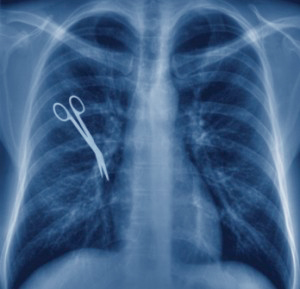Sources: Surgery, December, 18, 2012; MedScape

Surgical Malpractice is more common than we think. More than 4000 surgical “never events” occurred each year between 1990 and 2010 in the United States, according to the findings of a retrospective study of national malpractice data. Winta T. Mehtsun, MD, MPH, from the Johns Hopkins University School of Medicine in Baltimore, Maryland, and colleagues estimate that such errors cost the healthcare system millions of dollars each year in malpractice payments alone.
The term “Never Event” was first introduced in 2001 by Ken Kizer, MD, former CEO of the National Quality Forum (NQF), in reference to particularly shocking medical errors constituting surgical malpractice (such as wrong-site surgery or retained surgical instruments) that should never occur. Over time, the list has been expanded to signify adverse events that are unambiguous (clearly identifiable and measurable), serious (resulting in death or significant disability), and usually preventable. The NQF initially defined 27 such events in 2002. The list has been revised since then, most recently in 2011, and now consists of 29 events grouped into 6 categories: surgical, retained product or device, patient protection, care management, environmental, radiologic, and criminal.
“In an effort to incentivize patient safety in surgery, payers are increasingly focusing on these events that should never take place (surgical never events) as metrics of quality care,” the authors write. “Medicare and several states have already announced that hospitals will be penalized for such events in pay-for-performance programs.”
To estimate the frequency of surgical malpractice, the authors reviewed data in the National Practitioner Data Bank (NPDB) to identify malpractice settlements and judgments related to surgical never events occurring between September 1, 1990, and September 30, 2010. Using NPDB data and literature claim estimates, the authors estimated that surgical never-event claims occur at a rate of 4082 per year. Of the physicians involved, 62% (5903/9562) were named in multiple malpractice reports and 12.4% (1199/9562) were named in multiple surgical never-event malpractice reports.
In addition, physicians aged 50 to 59 years were more likely to have multiple surgical never-event claims than those younger than 40 years (aOR, 1.47; 95% CI, 1.13 – 1.93; P = .01). Physicians in other age groups (40-49 years, 60 years or older) were not significantly more or less likely to be involved in a malpractice claim than those younger than 40 years.
Limitations of the study include the potential underreporting of surgical never events because the NPDB records only paid claims on behalf of physicians, but not unpaid claims or claims paid on behalf of corporate entities. Additionally, the investigators note that a lack of hospital-level data, a lack of data on physician specialties, and a lack of data on types of surgeries and payments are also limitations.
The authors conclude that despite the work of multiple organizations, more effort is needed to reduce the incidence of surgical never events. “Investment is needed to create more robust, mandatory data collection systems concerning surgical never events, including subsequent thorough investigations by surgical health service researchers.”
The Lewis Law Firm handles cases of physician and hospital malpractice causing injury and death in Philadelphia and New Jersey. If you or a loved one were the vitim of wrong-site or wrong surgery, contact the Lewis Law Firm for a FREE consultation today.
